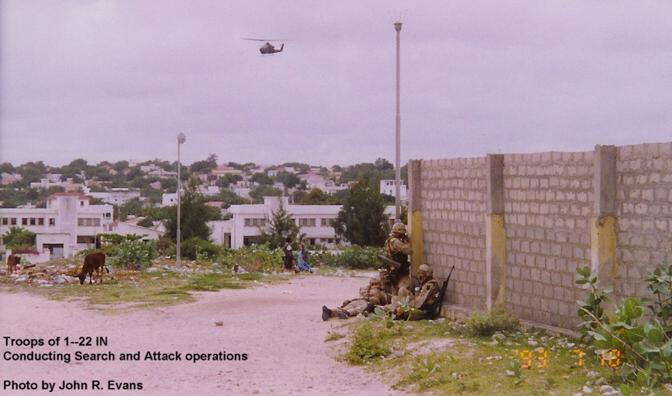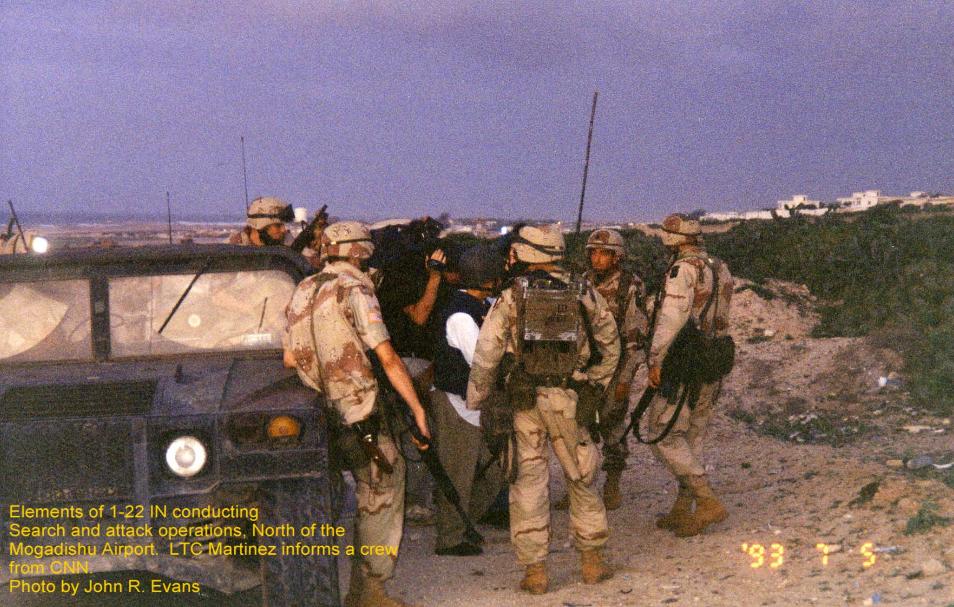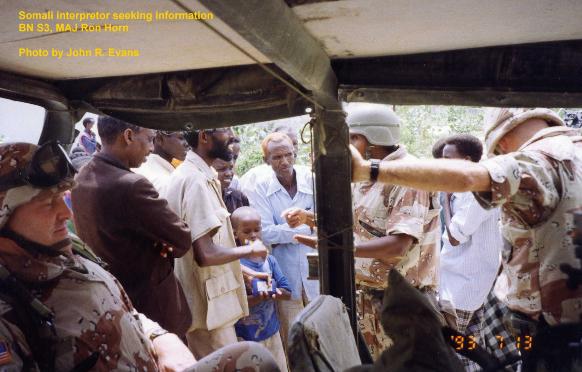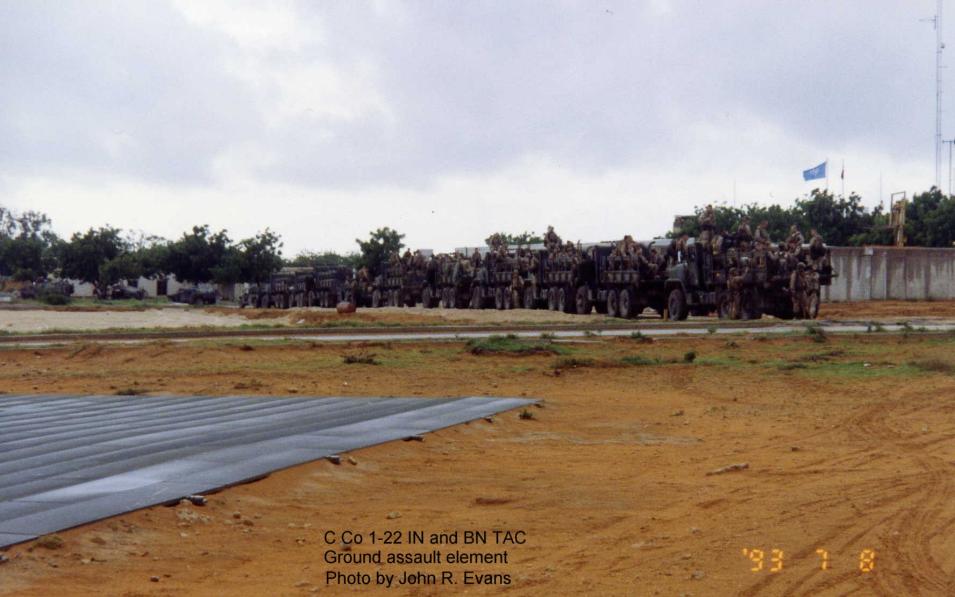![]() 1st Battalion 22nd Infantry
1st Battalion 22nd Infantry ![]()
TF 1-22 Infantry on the Horn of Africa:
OPERATIONS RESTORE AND CONTINUE HOPE—SOMALIA
Edited from TF 1-22 Infantry, from Homestead to Port au Prince
By MAJ John R. Evans, Command and General Staff College, 2000
Part Three
 Search and Attack ---- 1-22 Infantry |
The next date for attacks on additional SNA targets was set for 17 June 1993. The mission for that day focused on the Aidid neighborhood, located east-southeast from the Embassy and University Compound. That particular neighborhood was the location from which multiple sniper attacks on the Embassy were originating. The lead for the mission that day was the Pakistani brigade with additional Moroccan and Italian forces in support. The latter provided a cordon force around the Aidid neighborhood, while the Pakistani brigade conducted a search for weapons and any Somalis that were suspected snipers or that may have participated in the 5 June attack. The QRF was on standby to assist, if necessary, as an extraction or reinforcing force.
To facilitate the battalion’s mission, the commander designated the battalion intelligence officer to collocate with the Pakistani brigade headquarters to act as a liaison officer, and to provide the battalion headquarters with timely situation reports on the progress of the mission and to guide the battalion into the zone of attack if required. The Pakistani brigade headquarters controlled the operation from the outskirts of the Aidid neighborhood (also known as Aidid’s Garage) from atop one of the largest buildings in the vicinity of the area of operations near the K7 circle.
Based on their mission analysis, the Pakistanis had requested additional indirect fire support in the form of M203 grenade launchers that could assist with CS crowd control agents (crowds directly in the combat zone were becoming a problematic dimension on the battlefield) or, if necessary, High Explosives (HE) in case the situation got out of control and an immediate extraction was necessary. Two M203 teams (two men per team) from the battalion deployed under the C2 of the intelligence officer to fill the Pakistani request. The night before the mission, an AC-130 gunship launched preemptive attacks using both its 20 millimeter mini-gun system and its airborne 105 millimeter cannon. The ground attack began at 0545 hours with the establishment of the cordon and search by two Pakistani battalions (the 1st Punjab and 7th Frontier Force). Many firefights erupted both inside the area being searched and along the cordon area in the Moroccan sector. In one ambush, Somali gunmen inflicted heavy casualties on one Moroccan battalion. Sniper fire, coming from multiple locations, was extremely prevalent on any exposed unit or soldier throughout the area of operation. The mission ended at dusk on the 17th without capturing any of the targeted Somalis; however many cached weapons and mortar rounds were secured. Both Pakistani and Moroccan forces sustained casualties; there were no U.S. casualties.

LTC William (Bill) Martinez, CO 1-22 Infantry, talks to
CNN reporter
during Search and Attack Operations in the Mogadishu area,
July 5, 1993
From June 17th until July 11th, 1-22 Infantry conducted several other raids along with several search and attack missions. None of the missions produced the results desired by higher headquarters. Part of this was due to reliance on poor human intelligence sources. These sources, supposedly reliable, rarely provided the detailed information necessary to capture a suspect Somali or to uncover the exact whereabouts of a weapons cache.
A source of frustration for the soldiers was the near nightly ritual of mortar or RPG attacks at the base camp. Since the attacks by UN forces on 12 June, the base camp was subjected to increasing attacks that grew more lethal and accurate at each occurrence. Starting at about 2200 hours through about 0100 hours, Somali forces attacked the compound with harassing direct and indirect fire. These attacks resulted in a small number of U.S. and UN casualties; none were from 1-22 Infantry. Several requests by Lieutenant Colonel Martinez to patrol the areas outside of, and adjacent to the compound to stop the attacks were denied by higher authorities without explanation. This fact was significant, as the heavily bunkered Tunisian forces, responsible for perimeter security, conducted no active patrolling outside of the walls or bunkers. With the commander of 1-22 Infantry’s request continually denied, the result was that the SNA ruled the night and the units on the University Compound were forced to endure the incessant attacks.

1-22 Infantry BN S3, MAJ Ron Horn, waits in his humvee
while an interpreter questions local residents,
July 13, 1993
During late June and early July, an additional mission was proposed from higher headquarters and serious planning got underway for its execution. The new mission became affectionately known within the battalion’s leadership as the “Prize” or Aidid “Snatch” mission. The intent was to identify the location of Aidid and his party, send in the QRF via Black Hawk helicopters, capture him and bring him to justice for the original June ambush. In addition, it was hoped that Aidid’s removal would provide a calming effect on the agitated city. Additional training was conducted and TTP were developed in order to conduct the mission.
A few of the training events included intense air assault training between the infantry companies and the brigade’s Black Hawk Company. A new TTP was developed for the mission, that of mounting a Barret .50 Caliber sniper rifle, manned by a battalion scout sniper team, into a Black Hawk helicopter. The sniper team, with the powerful Barret, had the ability to disable key vehicles in Aidid’s convoy, thereby temporarily stopping its movement. This would allow the infantry assault teams that were airborne to land quickly and capture the prize. This mission, in fact, was attempted several times in late July and early August 1993, but to no avail. Either the intelligence was not accurate enough, or higher headquarters aborted the mission.
However, this was first attempted by 1-22 Infantry prior to other Special Operations Forces being assigned to the mission after August, as described in Mark Bowden’s book, Black Hawk Down.

C Company 1-22 Infantry conducting training for
"snatch" operations, July 8, 1993
Text and photos are copyright © John R. Evans 2005
Home | Photos | Battles & History | Current |
Rosters & Reports | Medal of Honor | Killed
in Action |
Personnel Locator | Commanders | Station
List | Campaigns |
Honors | Insignia & Memorabilia | 4-42
Artillery | Taps |
What's New | Editorial | Links |